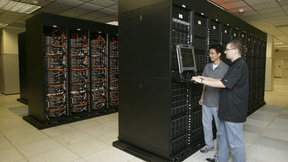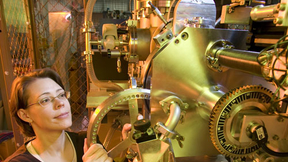Back
Laboratory Directed Research and Development
Lab researchers achieve record pressure for solid iron
Iron is the most abundant element in Earth's core and the sixth most abundant element in the universe. As a key component of terrestrial planets and exoplanets, iron has been one of the most studied materials under extreme conditions.In a series of campaigns led by the Lab's Yuan Ping using the OMEGA laser at the Laboratory for Laser Energetics (LLE) at the University of…
William Goldstein selected as Lawrence Livermore deputy director for Science and Technology
LIVERMORE, Calif., -- Lawrence Livermore National Laboratory Director Parney Albright has selected William Goldstein as deputy director of Science and Technology. Goldstein had served in this position in an acting capacity since September 2012. "Bill's proven scientific leadership abilities, his passion for developing and sustaining science, technology and engineering…
PLS names outstanding postdocs
What makes an outstanding postdoc? Ask members of the Physical and Life Sciences Directorate (PLS) who last month bequeathed the title on four individuals during an awards presentation by former Principal Associate Director Bill Goldstein.This award is given to postdocs with an exceptional level of accomplishment while working at LLNL. The 2012 PLS Outstanding Postdocs are…
Scientists create new atomic X-ray laser
Lab scientists and international collaborators have created the shortest, purest X-ray laser pulses ever achieved, fulfilling a 45-year-old prediction and ultimately opening the door to new medicines, devices and materials. The researchers, reporting today (Jan. 26) in Nature , aimed radiation from the Linac Coherent Light Source (LCLS), located at the Stanford Linear…
Grad student Swanberg recognized by APS
Erik Swanberg, a graduate student working in the Lab's Experimental Nuclear Physics Group, received the Margaret Burbidge Award from the American Physical Society (APS) California Section at the organization's fall 2011 meeting. Swanberg, who will earn a Ph.D. in nuclear engineering from UC Berkeley in May, has been conducting research at LLNL for three years. He was…
Seeing is believing: LLNL Postdoc reveals wonders of the protist world
No matter how sophisticated instruments have become, or how data intensive results may be, there is still something satisfying and frequently informative about seeing what a researcher is studying. Sometimes samples are so small, or so large, or so far away that it's almost impossible to get a visual perspective that makes any sense or reveals any insight. That's where the…
Livermore and Russian scientists propose new names for elements 114 and 116
The International Union of Pure and Applied Chemistry (IUPAC) today recommended new proposed names for elements 114 and 116, the latest heavy elements to be added to the periodic table. Scientists of the Lawrence Livermore National Laboratory (LLNL)-Dubna collaboration proposed the names as Flerovium for element 114 and Livermorium for element 116. In June 2011, the IUPAC…
Unclassified computing scales to new heights
Unclassified high performance computing at the Laboratory will scale new heights with the recent installation of Sierra, a Dell supercomputing system.Clocking in at a peak speed of 261 teraFLOP/s (trillion floating operation per second), Sierra will become the most powerful high performance computing (HPC) resource available for unclassified research at LLNL. The new…
Learning from climate's sedimental journey
By analyzing sediments up to 4,000 years old, Susan Zimmerman is hoping to provide a tool to help predict future climate change.Ancient records of what was happening with climate conditions can be used with regional climate models to tell a story of what happened in the past and to correlate it to the present and the future. Current models typically use data only for the…
Forensics helps NPS officer detect his niche
Major Bill Short's time at the Laboratory may turn out to be brief, but he believes it just might stand out as one of the most valuable experiences of his career.With 20 years of service in the U.S. Marine Corps, Short enrolled in the Naval Postgraduate School (NPS) in Monterey. There he learned about an LLNL research opportunity in the area of standoff detection of…
New accelerator is smash hit with Lab scientists
In the start of an experiment physicists believe will help resolve basic questions about the nature of the universe, the first proton beam was circulated Wednesday through the 17-mile-long Large Hadron Collider, the world’s most powerful particle accelerator. Located at the CERN particle physics research center near Geneva, Switzerland, the Large Hadron Collider (LHC) is a…
LLNL researchers peer into water in carbon nanotubes
LIVERMORE, Calif. – Researchers have identified a signature for water inside single-walled carbon nanotubes, helping them understand how water is structured and how it moves within these tiny channels.This is the first time researchers were able to get a snapshot of the water inside the carbon nanotubes.Single-walled carbon nanotubes (SWCNTs) offer the potential to act as…

















